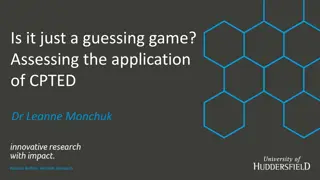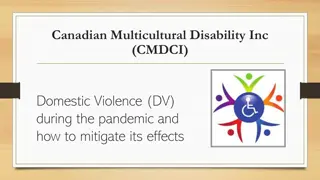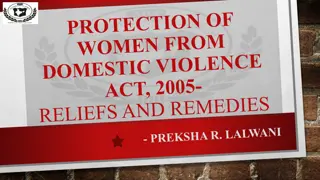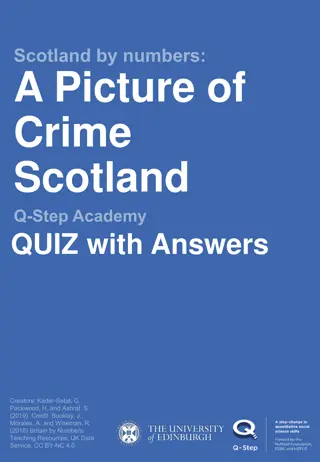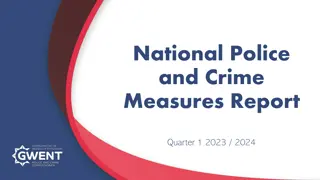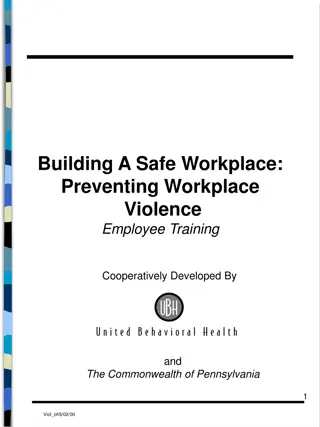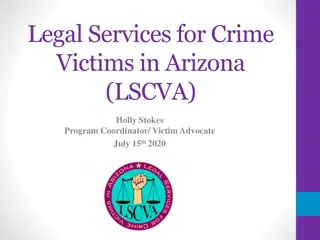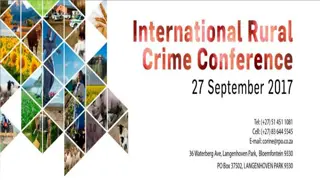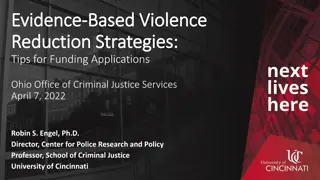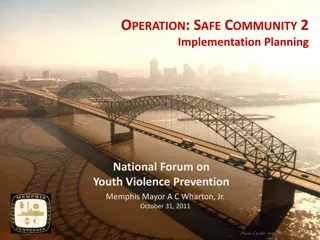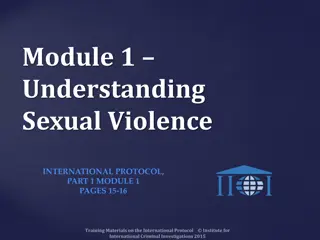Partnership Programme for Serious Violence and Organised Crime Overview
The Partnership Programme for Serious Violence and Organised Crime (SVOC) provides a comprehensive strategy to address issues related to serious violence, organised crime, and societal vulnerabilities. The program encompasses interventions, team structures, delivery mechanisms, and vision statements aimed at combatting these complex challenges effectively.
Download Presentation

Please find below an Image/Link to download the presentation.
The content on the website is provided AS IS for your information and personal use only. It may not be sold, licensed, or shared on other websites without obtaining consent from the author.If you encounter any issues during the download, it is possible that the publisher has removed the file from their server.
You are allowed to download the files provided on this website for personal or commercial use, subject to the condition that they are used lawfully. All files are the property of their respective owners.
The content on the website is provided AS IS for your information and personal use only. It may not be sold, licensed, or shared on other websites without obtaining consent from the author.
E N D
Presentation Transcript
THE PARTNERSHIP PROGRAMME FOR SERIOUS VIOLENCE AND ORGANISED CRIME
WHAT IS SERIOUS VIOLENCE AND ORGANISED CRIME? (SVOC)
OUR TEAM VULNERABILITY HUB COORDINATOR FIB TRIAGE PC 3 PCSOs 3 PCSOs 3 PCSOs POWYS 2 PCSOs CEREDIGION SPECIAL SERGEANT ANALYST PEMBROKESHIRE CARMARTHENSHIRE 3 SPECIAL CONSTABLES
DELIVERY STRUCTURE THE INTACT PROGRAMME Intelligent Communities Project Evening and Night Time Economy Centre Communications and Campaigns Early Intervention Operations Scepter (Knife crime) Aidant (MSHT) Training and Awareness Prevention Calendar Project Safe VAWG Makesafe (CE in Hotels/Taxis) Uchee Operation Makesafe Problem Solving Project Pathway Champions (Fast Parcels) Skylake (Small Vessel Imports) Joint Website and The Hub Guardian (County Lines) 121 Trusted Adult Work Setting the Bar High Safeguarding Operations Social Media (Facebook, Twitter, Instagram) Deepdale (Spiking) Project Based Learning
INTERVENTION CRITERIA Parental separation Family history of mental illness Family history of substance or alcohol misuse Lives in an area of high deprivation or within a deprived household: Employment: where any member of a household, who is not a full-time student, is unemployed or long-term sick Education: no person in the household has at least level 2 education (GCSEs and equivalent) Health / disability: any person in the household has general health that is very bad or has a long term health problem Housing: the household's accommodation is either overcrowded, i.e a family of 4 living in a 1 bedroom property, or is in a shared dwelling, or has no central heating Has demonstrated risky online behaviour, with access to inappropriate networks through social media and other channels Repeat missing person identified by the Missing Persons Coordinator / Llamau service Pro-criminal attitude with evidence of anti-social behaviour Have previously had an inappropriate intimate relationship Involvement in a gang culture Evidenced criminal skills and access to criminal networks, but have not been arrested or entered the CJS Close associate of a CE victim known to Dyfed-Powys Police Family members with a history of involvement in SOC, Serious Violence or prolific low level offending
WHAT WEVE ACHIEVED TO DATE 166 people have been allocated to the team between Mid-June 2021 and 29th October 2021. The take up rate for support is approximately 80%, which is higher than expected. It is anticipated around 40 new people will be identified each month across the 4 Local Policing Areas. Around 100 additional people have indirectly received support - often family or cares of those referred benefit from the intervention, such as onward referrals to Team Around the Family (TAF). Share of Protect records allocated from start to 29/10/2021 Projeted share of Protect records open from 01/02/2022 Ceredigion 9% Ceredigion 14% Carms 20% Carms 36% Powys 18% Powys 26% Pembs 53% Pembs 24%
WHAT WEVE ACHIEVED TO DATE Joint working and onward referrals to colleagues in youth services Boxing intervention in Pembroke Dock with children from across Pembrokeshire Joint work with BTP More than 2,500 people have received an input in at least one area of SVOC More than 100 licensees have received safeguarding training
INTERVENTION EXAMPLE Circumstances: A school referred 2 brothers, 7 and 10 years old, to the INTACT EIP Team. Mum has 6 children and was struggling to cope with their behaviour. Risk factors identified: Bereavement and drug use in the family, parental separation, diagnosis of ADHD and ODD, displaying signs of violence. Action taken: 1. Both boys attended the INTACT Project Safe group intervention. i. During the group sessions it became clear that there were wider concerns in the home environment and their violent behaviour was causing tension in the community. 2. Following the conclusion of the group sessions, Paul visited the family and spoke about a referral to Team Around the Family (TAF). Mum consented to having a referral to the service and Paul helped her complete the form. 3. Signposting to local football clubs was undertaken for the boys. 4. Due to violent behaviour in the street, a joint event with the housing provider ATEB was arranged and parents had a chance to put forward their concerns regarding safety and the lack of provisions for children and young people which could serve as diversionary activities. i. As a result, ATEB are seeking funding for a new MUGA (multi use games area) for the local children and young people to use. Outcome: The behaviour of the boys has improved at school as a result of the intervention, one of the boys is also now attending football club regularly and took part in the CLIW boxing intervention. Mum feels that she has received quality support from TAF and continues to have their support.
INTERVENTION EXAMPLE Circumstances: Mother of a 13-year-old male attended a police station and stated she was scared of the violent behaviour her sone was exhibiting. Risk factors identified: Social isolation, living in derivation, parental separation. Action taken: I visited David and his mother Georgia at home. I talked with Georgia, who said that she believes that David has a game addiction and stays up until 3am most days. We talked about confiscating devices, but Georgia said that she has done this before and David has become violent, threatening and has broken things. we then talked about limiting device time and finding other things that David likes to do. Georgia said that David enjoys swimming but they don't go because of the cost. I advised Georgia to visit the GP to discuss David s mental health and her concerns around his gaming addiction. I went away and found subsidised swimming classes and free swim sessions at the leisure centre and printed out the timetable. I visited Georgia and David again and showed them the swimming timetable. I has also printed out a weekly planner and we worked through it together talking about appropriate times to get up in the morning and appropriate bed times. Georgia signed David up for three swimming classes a week and that two hours of gaming a day was sufficient in the week planner. Outcome: I visited David and Georgia again. David is now having support from an Early Help worker and is attending swimming two or three times a week. He has reduced his time gaming and his behaviour has changed for the better, with far less violent outburst. Georgia has taken him to the GP and they are now waiting for an assessment for support around his gaming addiction.
INTERVENTION EXAMPLE Circumstances: Sam was having issues with online abuse from another child, who was sending her videos and messages to kill herself because nobody likes you this came to police attention via the school. Risk factors identified: Parental separation, inappropriate online behaviour, family history of mental health, living in deprivation. Action taken: Sam attended the Project Safe group intervention and built a good relationship with Rachel. It became apparent that there were other underlying concerns that had not been explored. Over the course of the intervention, Same made a number of disclosures about self harm, her sexuality and that she is violent towards some other children at school. Since Sam attended the group session, Rachel has undertaken one to one work with both Sam and her mother, supporting them to find the right help at the right time; including arranging interim counselling form a third sector organisation whilst Sam waits to access support from CAMHS. Rachel has also mapped out a number of sports clubs that are of interest to Sam. Rachel has provided Sam s mother with advice and useful resources to help educate Sam about online safety and her sexuality, as well as finding a local support group. A referral has also been made to TAF. Outcome: Sam has received some counselling and her behaviour has started to change for the better, Rachel continues to support Sam and her mother with occasional visits and continued signposting to local services as their circumstances are chaotic and change from day to day.


